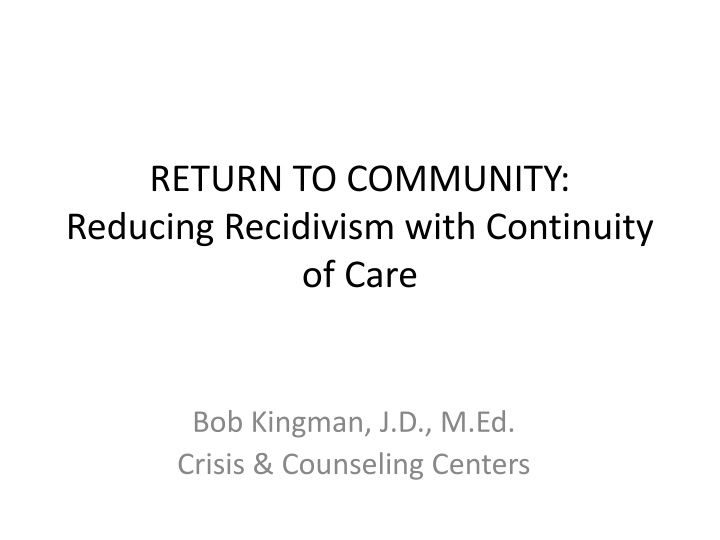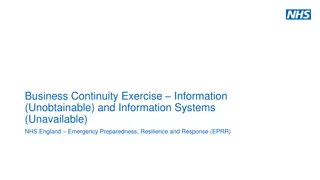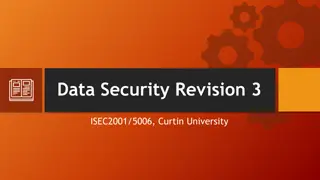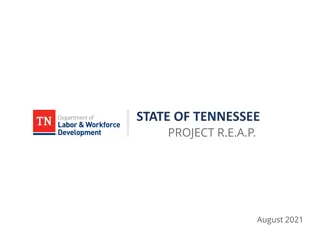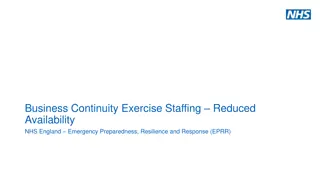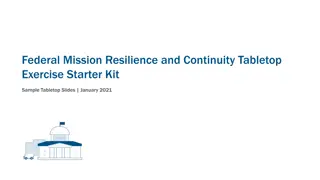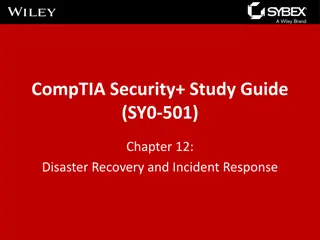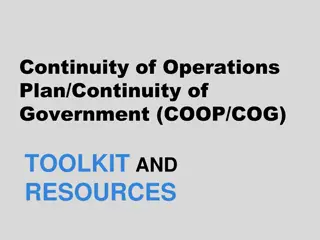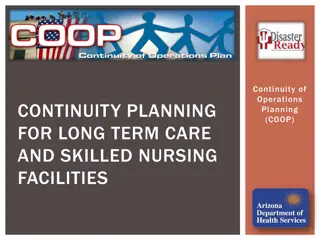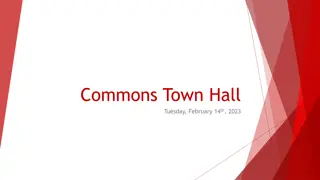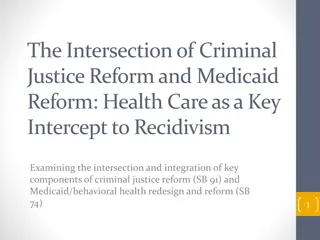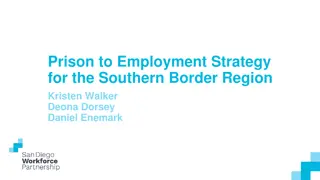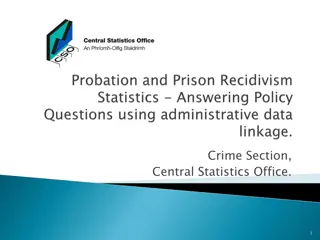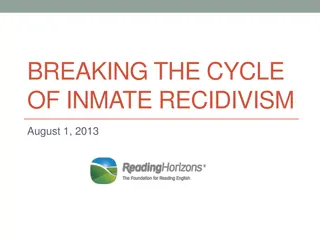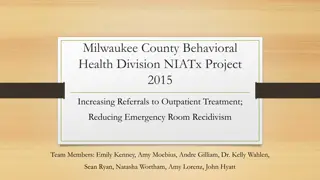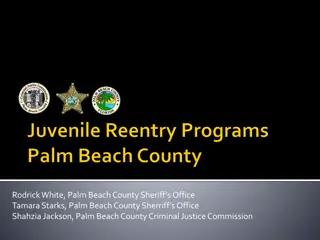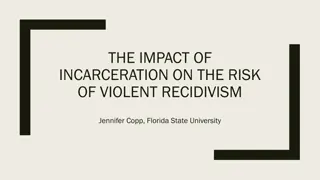Reducing Recidivism with Continuity of Care
Addressing the pressing issue of drug addiction in Maine and its impact on the community, this program focuses on reducing recidivism rates through continuity of care. By implementing compatible inpatient and outpatient treatment approaches, aftercare, and community supervision expectations, the program aims to provide a holistic solution to the growing problem. With a strong emphasis on transparency, consistent communication, and individual participant profiles, this initiative strives to make a meaningful difference in combating addiction and criminal offenses.
Download Presentation

Please find below an Image/Link to download the presentation.
The content on the website is provided AS IS for your information and personal use only. It may not be sold, licensed, or shared on other websites without obtaining consent from the author.If you encounter any issues during the download, it is possible that the publisher has removed the file from their server.
You are allowed to download the files provided on this website for personal or commercial use, subject to the condition that they are used lawfully. All files are the property of their respective owners.
The content on the website is provided AS IS for your information and personal use only. It may not be sold, licensed, or shared on other websites without obtaining consent from the author.
E N D
Presentation Transcript
RETURN TO COMMUNITY: Reducing Recidivism with Continuity of Care Bob Kingman, J.D., M.Ed. Crisis & Counseling Centers
OVERVIEW Program Continuation Transition to Community Aftercare treatment & continuity of care VIDEO: Program participants & program materials Discussion
OBJECTIVES Compatible inpatient & out-patient treatment approaches Aftercare and community supervision expectations Transparent/consistent communication CARA participant profiles
Problem Recognition in Maine 2015: 272 deaths from drug overdoses; a 31% increase from 2014 (208) 1013 babies drug-affected at birth; 8% of all live births in Maine (668 in 2011). 1800 criminal convictions involving opiates/heroin class. Increased from 1500 in 2014 and 1300 in 2013.
..the horror of heroin and opiate addiction in our youth, our middle-aged citizens and even mature Mainers is growing ..the wave of drug addictions is eating at the heart of our beautiful state. Leigh Saufley, Chief Justice, Maine Supreme Court
Integrated Treatment & Supervision Has Most Impact Translating Crimino Risk 2013 6
Treatment Impact on Recidivism Rates Stephanie Lee, Steve Aos, Elizabeth Drake, Annie Pennucci, Marna Miller, Laurie Anderson, Return on Investment: Evidence-Based Options to Improve Statewide Outcomes, (Olympia: Washington State Institute for Public Policy, April 2012); D.A. Andrews and James Bonta, ColorPlot Profile Form for Men, The Level of Service Inventory - Revised: U.S. Norms, (North Tonawanda: Multi-Health Systems, Inc., 2003). Translating Crimino Risk 2013 7
Need to Retool? Traditional SA/MH treatment Criminal Justice Partnership Overlapping populations Revolving door Criminogenically informed Translating Crimino Risk 2013 8
The Basics Treatment Works! Yes CBT, but Aim for criminogenic targets! Risk Need Responsivity Dosage Treatment Translating Crimino Risk 2013 9
Continuity: concepts & definitions Criminogenic Pro-social Anti-social Entrenchment Desistance Pathway In: Session 1 10
CARA Philosophy give people adequate information, in a respectful supportive environment that enhances pro-social values, with adequate support inside and outside a jail setting and pro-social change is possible. Pathway In: Session 1 11
Effects of Social Disengagement Prolonged exposure to negativelydefines self, other, and community Adaptive behaviors result in an accumulative anti-social culture Pro-/Anti-social culture is reinforced and influences decisional balances OK Not OK Self Significant Others Community Criminogenic Change 12
Needs met with negation and exclusion Adaptive behavior weakens social bond Anti-social adaptation becomes culturally reinforced Social Disengagement Criminogenic Change 13
Expectation Social Capital Obligation Human Capital Trust Criminogenic Change 14
Pro-Social Amplification Welcoming and Inclusion Pro-social behavioral supports Pro-social capital and bonding Amplify pro- social motivations and identity Reintegrative Shame Pro-social reinforcement Criminogenic Change 15
What is Best Practice? 8 Evidence Based Principles to Reduce Recidivism 1. Assess Risk/Needs 2. Identify and enhance the individual's motivation 3. Target Criminogenic Targets a. Risk Principle b. Need Principle c. Responsivity Principle d. Dosage e. Treatment Principle 4. Experiential, hands on , practical treatment 5. Highlight pro-social values and behaviors 6. Multi-disciplinary team approach 7. Measure Criminogenic outcomes 8. Provide 360 degree feedback http://cjinstitute.org/files/evidencebased.pdf Gender Informed Strength-based Translating Crimino Risk 2013 16
Targeting Criminogenic Need: Results from Meta- Analyses Reduction in Recidivism Increase in Recidivism Source: Gendreau, P., French, S.A., and A. Taylor (2002). What Works (What Doesn t Work) Revised 2002. Invited Submission to the International Community Corrections Association Monograph Series Project Translating Crimino Risk 2013 17
Scope of Treatment Traditional: Symptom reduction Criminogenic: Pro-social engagement Translating Crimino Risk 2013 18
Early Treatment Expectations of Psychotherapy It doesn t help I ll have to give something up Entertainment Shame-based Salvation Unsafe of the Clinician From a different planet Represents the system to be played of themselves Passive Be in control Be guarded Play the game Translating Crimino Risk 2013 19
COMMON GOAL: BEHAVIOR CHANGE Perception + Feelings + Thoughts + Actions _________________ BEHAVIOR
Behavior changes when: Our needs change Old behavior is replaced New behavior plans are tested upon return to the community Pro-social pull and anti-social drift
Clinicians, case mgrs and POs are from the Pro-social Club! THINGS TO KEEP IN MIND Criminogenic process is more powerful than a vague desire to change Pro-social consequences can be accumulative Sustainable change is relationship based Translating Crimino Risk 2013 22 22 22
Advantages of Care Continuity Facilitators are familiar Understanding is enhanced/build on prior knowledge Consistent treatment philosophy Risk factors can be focused on in more depth Communication/investment in community supervision process=less of treatment barrier DISADVANTAGES Ineffective therapeutic relationship Risk of clinician s BS meter malfunction
Examples of IOP Treatment Materials Situational confidence questionnaire Substance abuse change plan IOP group materials & outline
Brief Situational Confidence Questionnaire Right now I am confident [0%-100%]to resist the urge to use/abuse substances in situations involving: (1) Unpleasant emotions (2) Physical discomfort (3) Pleasant emotions (4) Testing control over my use of alcohol or drugs (5) Urges and temptations (6) Conflict with others (7) Social pressure to use (8) Pleasant times with others
Participant Profiles Video: Panel Discussion Having all the tools needed for a successful return to community
Community Supervision Treatment without supervision is likely to be much less effective Value in understanding different responsibilities and differing philosophies Transparent team communication Use of random drug testing Sanctions and rewards
CRIMINOGENIC ADDICTION RECOVERY ACADEMY CARA CASE MANAGEMENT Maine Pretrial Services
In custody Identify any pro-social community supports Help secure the safest housing available Help obtain any necessary identification Make referrals as needed Prepare and submit all release paperwork Review all conditions of release Positive support for release to the community
In the community Regular and random substance screening Weekly meeting with CARA team Verification of treatment progress Medication accountability Conditions of release compliance Violation notifications Home and activity visits General community support as needed
Participant Profiles: different pathways to recovery horizons David Jeromy
Davids Interview Comments on interview and David s treatment experience(s)
Jeromys Interview Comments on interview Compare/contrast Dan s & Jimmy s experiences Highlight modifications to CARA program
Modifications to CARA Program Phase 1: In-facility CARA Program ONLY; no IOP/aftercare, some supervision. Phase 2: In-facility CARA, some S/V and IOP treatment; w/o continuity (1-5 weeks). Phase 3: In-facility CARA; mandated IOP with variable S/V and some treatment continuity. Phase 4: In-facility CARA; mandated IOP with continuity and deferred disposition supervision for 12 months.
Addressing dynamic risk factors/ criminogenic needs Dynamic Risk/Crimonogenic Need Factor Action History of antisocial behavior Build alternative behaviors Antisocial personality pattern Problem solving skills, anger management Antisocial cognition Develop less risky thinking Antisocial attitudes Reduce association with criminal others Family and/or marital discord Reduce conflict, build positive relationships Poor school and/or work performance Enhance performance, rewards Few leisure or recreation activities Enhance outside involvement Substance abuse Reduce use through integrated treatment Source: Andrews (2006)
Determine Dosage and Intensity of Services Higher-risk individuals benefit from significantly more structure and services than lower-risk offenders (Bourgon & Armstrong, 2006; Gendreau & Goggin, 1995; Latessa, 2008) Higher-risk: 300 hours Moderate-risk: 200 hours Low-risk: 100 hours During the initial three to nine months post-release, 40%- 70% of high-risk individuals free time should be occupied with delineated prosocial routines and appropriate services
37 Service Delivery Principles- How You Do It Based Primarily on Risk of Recidivism Lower-Risk Higher-Risk Service Delivery Principles Less Intensive Application for Lower-Risk Individuals More Intensive Application for Higher-Risk Individuals Avoid intensive engagement and case management Intensive case management with frequent contact Engagement Timing is still important, but less of a priority for lower-risk individuals Connect with individuals before release from jail/prison Timing Incentives are less of a priority and need for lower-risk individuals Enhance motivation through communication and incentives Incentives Community supervision should not be intensive, and officers do not have to play as active a role Work closely with community supervision officers, who can assist with intensive engagement Coordination Avoid structuring time that disrupts existing pro-social ties Highly structured time to provide a pro-social environment Structured Time
The challenges of implementing effective interventions Requires a dedicated commitment to change by managers, line staff, and everyone in between - Not just in corrections agencies, but in all service delivery agencies Requires an increased emphasis on accountability for our work individual and collective Requires us to reconsider current practices and let go of the that s always how we ve done it philosophy Requires us to confront and address resistance
39 Principles of Drug Abuse Treatment for Criminal Justice Populations- NIDA Treatment should target factors that are associated with criminal behavior Supervision should incorporate treatment planning for drug abusing offenders, and treatment providers should be aware of correctional supervision requirements Continuity of care in the community is essential A balance of rewards and sanctions encourages prosocial behavior
Reentry interventions for people with substance use disorders on community supervision CBT and relapse prevention: Several manualized CBT programs for adult offenders Cognitive Intervention Program (NIC) Moral Reconation Therapy Reasoning and Rehabilitation Thinking for a Change (NIC) Case management (mixed results) Contingency management and motivational enhancement techniques Residential treatment Pharmacotherapy Tailoring programming and strategies to special populations Continuing Care Prendergast, M.L., et al. (2009). Interventions to promote successful reentry among drug- abusing parolees. Addiction Science & Clinical Practice.
Responses to technical violations Swift and certain responses rooted in human development research CERTAIN Sanctions and incentives are clearly defined before noncompliance occurs. Responses are applied consistently when goals are met or noncompliance occurs. Certainty increases the offender s perception that supervision responses are fair which increases compliance. SWIFT Sanctions or incentives occur immediately after violation. GRADUATED Responses are matched or proportionate to the severity of the violation. The severity of the response increases with the number and severity of the violation. 41
Graduated Response Matrix Handout(s)
Ratio of Rewards to Punishments and Probability of Success on Intensive Supervision 90% 81% 80% 80% Probability of ISP Success 77% 70% 71% 60% 57% 50% Greater LONG term behavioral change attained through positive reinforcement rather than punishment contingencies. 40% 30% 20% 20% 11% 10% 9% 8% 7% 0% 1:10 1:08 1:06 1:04 1:02 2:01 4:01 6:01 8:01 10:01 Ratio of Rewards to Punishments Source: Widahl, E. J., Garland, B. Culhane, S. E., and McCarty, W.P. (2011). Utilizing Behavioral Interventions to Improve Supervision Outcomes in Community-Based Corrections. Criminal Justice and Behavior, 38 (4). 43
Why Positive Reinforcement Works Punishment STOPS behavior doesn t replace it with appropriate behavior. It is important to reinforce a competing response by acknowledging the appropriate behavior. 44
Principles of effective interventions 1. Screen and assess for behavioral health and criminogenic risk and needs 2. Enhance instrinsic motivation 3. Target interventions according to the risk/need/responsivity/dosage principles 4. Skill train with directed practice using CBT methods 5. Increase positive reinforcement/ graduated responses 6. Firm but fair supervision tailored to risk level 7. Engage ongoing support in natural communities 8. Measure relevant processes/practices 9. Provide measurement feedback NIC, 2004: https://s3.amazonaws.com/static.nicic.gov/Library/019342.pdf
CONCLUSIONS/TAKE-AWAYS Common purpose/goal(s) Collaboration and investment (training, etc.) Consistency and structure Community supervision Continuity of care Careful modifications and restructuring
